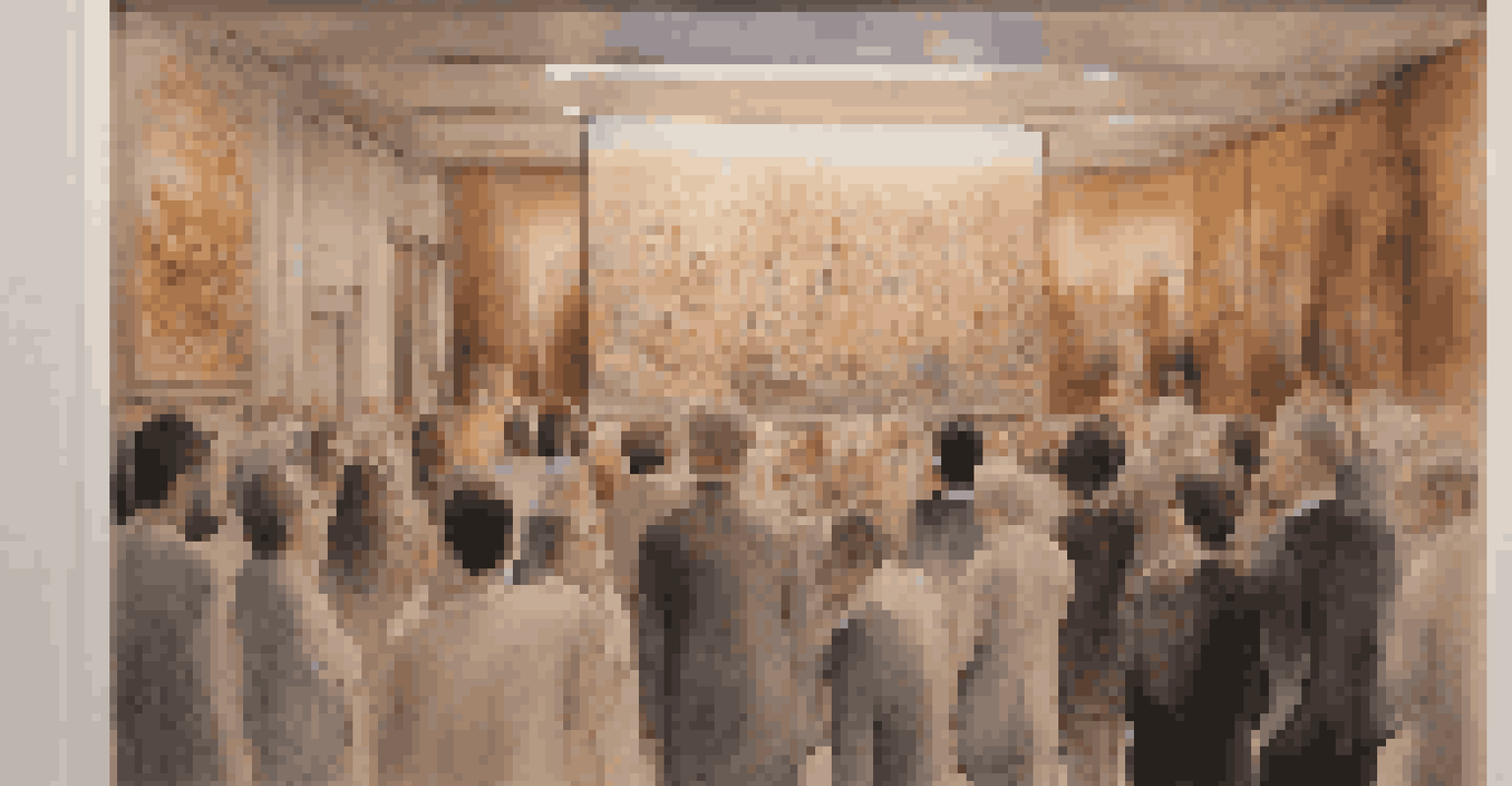The Role of Auction Houses in Shaping Art Collecting Trends

Understanding the Role of Auction Houses in Art
Auction houses have long been pivotal in the art market, acting as intermediaries between artists and collectors. They provide a platform where artworks can achieve visibility and are sold to the highest bidder. This environment not only facilitates transactions but also helps shape the cultural landscape by highlighting certain artists and styles.
Art is not what you see, but what you make others see.
By curating collections and selecting pieces for auction, these houses influence which artworks become desirable. For example, a well-publicized auction can elevate the profile of an emerging artist, while established names can see prices soar based on competitive bidding. This dynamic creates a ripple effect in the art community, often leading to increased interest and investment in specific genres or movements.
Moreover, auction houses often collaborate with galleries and museums, further promoting certain artists and styles. This partnership can help create trends, guiding collectors’ purchasing decisions and ultimately shaping the art market itself.
How Auction Houses Influence Market Trends
The auction market is a powerful indicator of art trends, with sales data often reflecting broader economic conditions. When a particular artist’s works fetch high prices at auction, it signals their rising status and can lead to increased demand. Collectors often look to these auction results for guidance on what to invest in, creating a feedback loop between auction houses and market trends.

For instance, the record-breaking sale of a piece by a contemporary artist can spark a surge in interest in similar works, driving prices up across the board. This phenomenon highlights the auction house's role not just as a sales venue, but as a trendsetter that can dictate what is hot or not in the art world.
Auction Houses Shape Art Trends
By curating collections and hosting auctions, these houses influence which artists and styles gain prominence in the art market.
Furthermore, auction houses often capitalize on these trends by promoting upcoming auctions with themed collections, which can create buzz and anticipation. This strategic marketing not only enhances sales but also influences collectors' perceptions of value and desirability.
The Impact of Online Auctions on Art Collecting
In recent years, the rise of online auctions has revolutionized the way art is bought and sold. Platforms like Sotheby’s and Christie’s have expanded their reach, allowing collectors from around the globe to participate in auctions from the comfort of their homes. This accessibility has democratized art collecting, making it more inclusive and diverse.
The best artist has no conception that a marble block does not contain in itself; it is the sculptor who must bring it to life.
With online auctions, collectors are no longer limited by geographical boundaries. An artwork that might have been overlooked in a local market can gain international attention, leading to higher bids and broader appreciation. This shift has also encouraged new collectors to enter the market, bringing fresh perspectives and interests.
However, this trend also presents challenges, as the sheer volume of available art can overwhelm buyers. Collectors now must navigate a digital landscape filled with options, making it crucial for them to stay informed about trends and valuations. Auction houses have responded by offering educational resources and expert insights to help collectors make informed decisions.
Auction Houses and the Rise of Contemporary Art
Auction houses have played a significant role in the rise of contemporary art, providing a platform for living artists to gain recognition. This focus on contemporary pieces has reshaped the art market, moving it away from traditional works and embracing innovative forms of expression. As these auction houses highlight contemporary artists, they also create a narrative around the ever-evolving nature of art.
For instance, the auction of Banksy’s 'Girl with Balloon,' which famously self-destructed after being sold, captivated global audiences and sparked discussions about the intersection of art and commerce. Such events not only attract media attention but also draw in a younger, more diverse audience eager to engage with modern art.
Online Auctions Expand Accessibility
The rise of online auctions has democratized art collecting, allowing global participation and attracting new collectors.
This shift has encouraged collectors to diversify their collections, moving toward contemporary works that reflect current societal themes and personal narratives. With auction houses leading the charge, the art market continues to evolve, embracing new voices and pushing boundaries.
The Role of Auction Houses in Establishing Value
One of the most important functions of auction houses is establishing the market value of artworks. Through competitive bidding, they create a transparent pricing structure that reflects demand. This process not only helps sellers understand what their art is worth but also assists buyers in gauging the investment potential of their purchases.
However, the perceived value of art can be influenced by various factors, including provenance, condition, and market trends. Auction houses often provide this context, offering catalogs that include detailed descriptions and historical significance. This information empowers collectors to make informed decisions and understand the nuances of the market.
Moreover, auction houses frequently collaborate with appraisers and experts to ensure accurate valuations. This professional insight not only builds trust but also reinforces the auction house's credibility as a leader in the art market.
Auction Houses and the Global Art Market
With the globalization of the art market, auction houses have become key players in connecting collectors, artists, and dealers from around the world. They facilitate international sales and collaborations, showcasing art from various cultures and backgrounds. This global reach enriches the art market, allowing for a more diverse range of works to be appreciated.
For example, a piece by an Asian artist might find its way to a collector in Europe, broadening the audience for that artist's work. This not only benefits the artists but also cultivates a richer cultural dialogue within the art community. Auction houses often hold themed auctions that celebrate cultural diversity, further emphasizing their role in the global landscape.
Valuation is Key for Collectors
Auction houses establish the market value of artworks through competitive bidding and expert insights, helping buyers and sellers navigate the art market.
As they navigate different markets, auction houses help set trends that resonate across borders. By highlighting international artists, they encourage collectors to explore beyond their local scenes, fostering a more interconnected art world.
The Future of Auction Houses in Art Collecting
Looking ahead, auction houses are poised to continue shaping the future of art collecting in exciting ways. As technology evolves, we can expect further innovations in how art is presented and sold, potentially enhancing the auction experience for collectors. Virtual reality tours and augmented reality previews may soon become standard, allowing buyers to engage with art in new dimensions.
Additionally, the growing importance of sustainability and social responsibility in the art world will likely influence auction houses' practices. Many are already embracing environmentally friendly initiatives, such as promoting art made from recycled materials or supporting artists who advocate for social causes. This shift reflects a broader cultural awareness and may attract a new generation of collectors who value sustainability.

Ultimately, the role of auction houses in shaping art collecting trends will remain significant. As they adapt to changing dynamics and embrace new technologies, they will continue to play a vital role in the evolution of the art market.